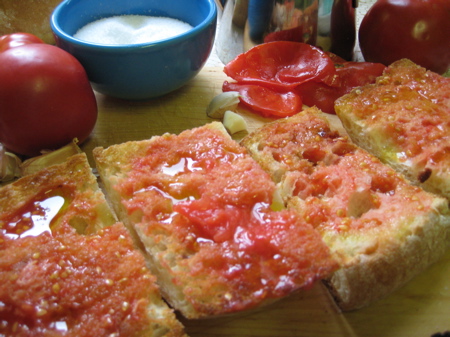
Teresa Parker blogs about restaurants, recipes, and the reasons why she's in love with Spain's food and culture.

Forget about butter and jam on your morning toast (and maybe all that pre-dinner double-dipping of bread in olive oil, too). The Catalans have a better idea: pa amb tomàquet, bread with tomato.
Add a smidge of garlic, olive oil, and salt, plus a slice of protein—sheep's milk cheese or dry cured ham—and you've got a complete breakfast. Pa amb tomàquet is like biscuits and gravy: a perfect pairing that got its start down on the farm, but has since made its way to big city tables. Here in the New World it is found on "tapas" menus and recipe pages described as a Catalan specialty but given a new name based on a translation, inexplicably, not into English but into Spanish: "Pan con Tomate."
Whatever you call it, it is just about the most scrumptious thing you can do with a late summer tomato. And there's nothing to it. As long as you do things in the proper order. Rubbing the toast with tomato after drizzling on the olive oil will not do—you need the crusty toasty surface to act as a sort of grater for grabbing the garlic and the tomato and you want the olive oil to dress the top juicily.
Oh, wait. Did I say there's nothing to it? There is one challenge to getting this "recipe" right. It's the ingredients.
With something this simple, the flavor of each element matters exquisitely. The bread should be real bread, a rustic round, substantial and crusty. It also works to use ciabatta, which makes a daintier version but offers the advantage of being extra hole-y. The salt should be sea salt or kosher salt with a nice crunchy texture, but not that great big coarse stuff.
And the tomatoes should be the small, juicy, thin-skinned kind, and ripe. The season can be stretched well into fall, though. This year, after a summer without tomatoes, the fall ones in my Cape Cod garden seem just perfect. In Spain, when the last late fall tomatoes ripen, people pull the whole plant out of the ground and hang it upside down in a cool, dark pantry or attic. Now that's my kind of transubstantiation: the tomatoes last deep into winter, their flavors concentrating to perfection.
Once you've gathered these good ingredients, here's a recap of how things go down:
The rustic version is a DIY thing, but you could take charge of the toasting, doling out a big slab of bread (or a couple of pieces of daintier ciabatta) to each eater. If you happen to be grilling, by all means toast your bread on the grill. Everyone also needs a garlic clove and a ripe little tomato or two and your pitcher of olive oil and bowl of flaky salt within reach. They should first rub the hot toasts lightly with the flat side of the garlic—they should not feel compelled to use the whole piece, a little goes a long way. Then they'll rub the tomato halves onto the toast, gently squeezing so the pulp mashes onto it generously. Next they'll drizzle on the olive oil. Skimping on that should be discouraged. A pinch of salt goes on last.
Or here's a make-ahead version that works well for a big party or one that doesn't invite the do-it-yourself scene described above. Prep the tomatoes (one—or two if they're tiny—per person) ahead of time using one of Spain's great cooking tricks: grating. Halve them and press them pulp side down along the big holes of a plain old grater, catching the juice and pulp in a bowl, and grating all the way down, so you're left with nothing but the stripped-down tomato skin in your hand and a big bowl of juicy tomato pulp. Slice a whole ciabatta (one for every four eaters or so) in half crosswise, exposing its flat, hole-y bellies to the fire or toaster. When the bread is toasty, scrape on the garlic, lightly, spoon on the tomato, drizzle the whole show with oil, sprinkle with salt, and whack into pieces.
